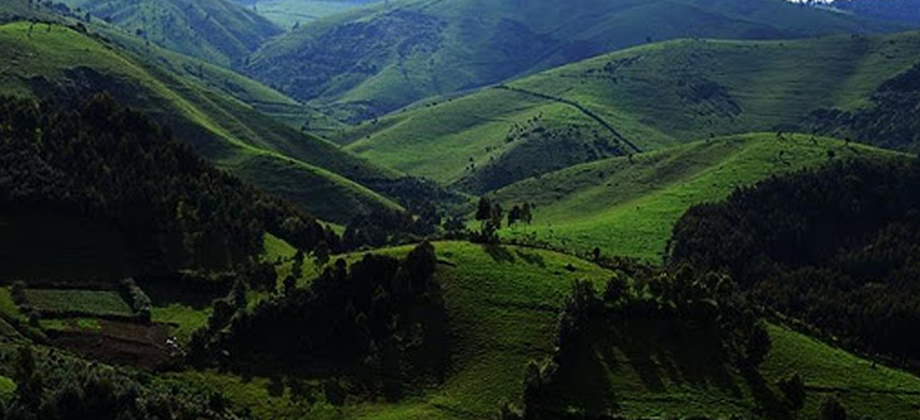Bwindi impenetrable National Park is 321km at an altitude of 1,160m -2,607m above sea level. It was gazetted as a national park in 1991 and declared a UNESCO Natural World Heritage Site in 1994. The park is spread over a series of steep ridges and valleys, and it’s the source of the major five rivers that flow into Lake Edward.
Bwindi Impenetrable National Park lies in south western Uganda on the edge of the Rift Valley. Its mist-covered hillsides are blanketed by one of Uganda’s oldest and most biologically diverse rain forests, which dates back over 25,000 years and contains almost 400 species of plants. More famously, this “impenetrable forest” also protects an estimated more than 480 mountain gorillas – roughly half of the world’s population, including several habituated groups, which can be tracked.

What or how is Bwindi Altitude and elevation like? Rising high in the Kigezi hillside, Bwindi Impenetrable National Park (BINP) is set at an altitudinal range of 1160m to 2607m. The park is most famous for mountain gorilla trekking adventure, an extra-ordinary experience that is completely different from the normal city walks. A visit to Bwindi for a holiday requires you to be prepared not only for the weather changes but also altitudinal challenge.
The park is located at the edge of the Western Rift Valley in the highest parts of the Kigezi Highlands, which were created by up-warping of the Western Rift Valley. The topography of the park is very rugged, with narrow valleys intersected by rivers and steep hills. Altitudes in the park range from 1,190 to 2,607 meters above sea level, with 60% of the park having an elevation of over 2,000 meters above sea level. The highest elevation in the park is Rwamunyonyi hill at the eastern edge of the park and the lowest part of the park is located at its most northern tip.
At an altitude of 1160-2607m, Bwindi features steep terrains and on a search for mountain gorillas, at times, your park guide will assist clear pathways for you. It is a long trek while searching for the endangered mountain gorillas in Bwindi Impenetrable Forest. On a normal day, you should be prepared to spend at least 2-6 hours trekking through the steep terrain, muddy ground and dense rainforest cover of Bwindi.
Bwindi National Park’s highest peak is Rwamunyonyi, located in Ruhija sector –the Eastern region. Rwamunyonyi peak rises at the elevation of 2607m and the amazing bit of it is that, over 60% of the park altitude is at an altitude of 2000m.
It is on the highland areas of Bwindi NP where you can find 5 main rivers. This is where they start descending into Lake Edward, Bunyonyi and Mutanda. The area experiences rainforest amount of 1400 to 1900mm.
On average, the warmest month is January. Altitude varies from 1160m to 2607m above sea level, which results in variations in temperature. The park is also close to the equator so rain can come when you least expect it. Generally Bwindi Impenetrable forest does not experience real dry seasons because even the known dry seasons do receive some short rains.
This national park lies in south western Uganda on the edge of the Rift valley and its covered in hillsides that are blanketed by one of Uganda’s oldest and most biologically diverse rain forests, that date back over 25,000 years and has almost 400 species of plants and has got half of the world’s population including the habituated groups that can be tracked.
This biologically diverse region offers shelter to chimpanzees and baboons as well as elephants and antelopes. There are over 350 bird species that are hosted in this forest including the 23 Albertine Rift endemics. The nearby towns of Buhoma and Nkuringo have an impressive array of luxury lodges, rustic bandas and the budget campsites, and the restaurants, craft and guiding services. The opportunities here are to discover the local Bakiga and Batwa pygmy cultures through performances, village walks and the workshops.
Is altitude sickness a possible problem on gorilla treks in Bwindi Impenetrable Forest?
To some travelers who have gone gorilla trekking in Bwindi, the elevation has not been a big concern. Though the climbs can be steep and the terrain is a bit high, altitude sickness is not a serious concern.
How fit should you be for gorilla trekking?
Considering the kind of terrain, you must conduct adequate exercise prior to your normal gorilla trekking adventure. This can save you from the possible altitude sickness some guests may experience. What is remarkable though is that Bwindi National Park’s elevation doesn’t come with severe altitude sickness like hikes to the summits of the Rwenzori Mountains.
